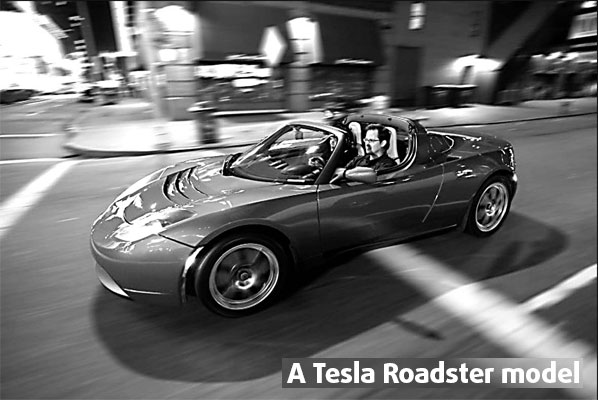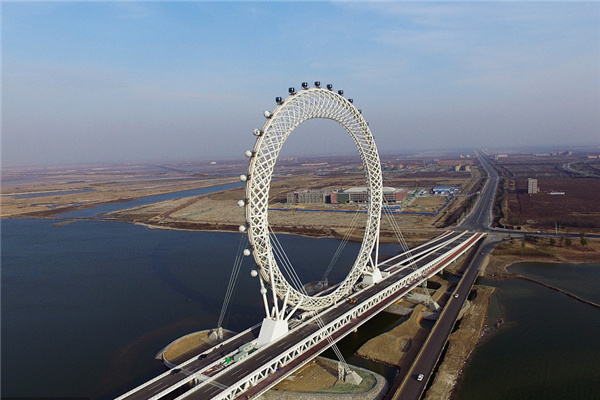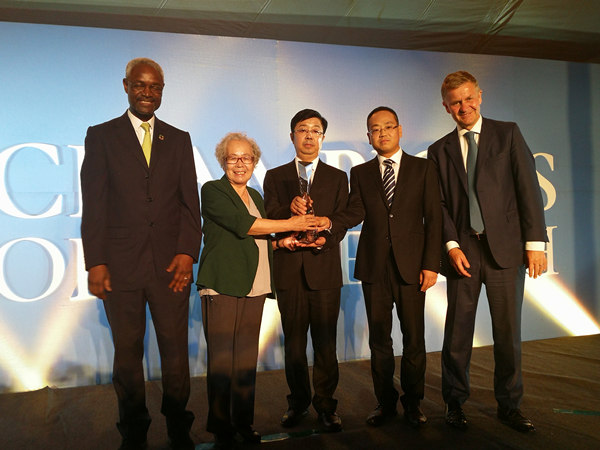


As soon as the driver hits the accelerator, you are thrown back against the seat. The car climbs from 0 to 100 km per hour in about four seconds, as advertised. But unlike a Porsche or Ferrari, there are no fumes or gear changes and not much noise.
The 2008 Tesla Roadster, totally powered by electricity and unveiled in March in California, produces only one-tenth of the pollution of a normal gasoline-powered car. It is six times as energy efficient as the best sports car and produces zero tailpipe emission. More than just a commuter car, it easily achieves 450 km per charge.
"The electric sports car will fundamentally change the way we drive," predicts Tesla Motors CEO Martin Eberhard.
The auto company is named after Nikola Tesla (1886-1943), a Serbian-American inventor and electrical engineer now hailed by many as the "patron saint of modern electricity" but who was ultimately ostracized and regarded as a "mad scientist" in his lifetime due to his eccentric personality and unbelievable and sometimes bizarre claims about possible scientific and technological developments.
But there is nothing bizarre or unbelievable about his namesake auto and ohers are also hailing it.
Ditlev Engel, president and CEO of Vestas Wind Systems A/S, says in Beijing that the Tesla Roadster provides a "marvelous, clean and renewable solution" to traditional transport. The Denmark-based company knows green power. To date, it has installed more than 32,500 wind power turbines in more than 60 countries worldwide.
"Vestas has booked a Tesla Roadster to a showcase of our business," he adds.
An analysis by the World Wildlife Fund, released in early April, found that plug-in hybrid and battery charged electric vehicles offer a promising pathway to a sustainable transport future that reduces risks of climate catastrophe and possible conflict over dwindling oil resources.
The report, "Plugged in: the End of the Oil Age", considers the future of a transport sector now 95 per cent dependent on liquid hydrocarbon fuels and examines the potential impacts and practicalities of electricity versus other oil substitutes that could fuel a future transport system.
It finds that vehicles running solely or partly on electricity supplied from the grid are significantly more efficient and may emit fewer greenhouse gases than many so-called alternative fuels, even when that electricity is mostly produced using fossil fuels.
Less polluting power generation and more use of renewable energies make it certain that the comparative efficiency and pollution advantages of plug-in transport solutions will improve, the report says.
"We should all be relying more on walking and biking, on buses and trains, to get to where we need to go," says James Leape, Director General of WWF International.
"But cars will inevitably remain a major part of the transport equation. The cars of the future must be much more efficient - smaller, lighter, more aerodynamic - and they should, increasingly, be powered by electricity."
As oil becomes more difficult to access, techniques to create liquid fuels from coal are now being vigorously pursued in the US, China, India, Australia and South Africa.
"Coal-to-liquid fuels are costly, energy intensive and extremely polluting, and have previously only been used on any significant scale in countries facing a state of emergency," says report author Gary Kendall.
Other alternatives to traditional oil extraction include exploitation of oil sands, which generates three times the emissions of petroleum processing and causes devastation to the local environment.
The report also finds that the electric vehicles can be three times more efficient than hydrogen-fueled vehicles and, more importantly, can already be achieved using existing technology and distribution infrastructures.
"Automotive transport is ripe for transformation," says Kendall. "We need to accelerate the commercialization of vehicles with diversified primary energy sources, high efficiency and compatibility with a sustainable, renewable energy future. The electrification of automotive transport offers a promising way to achieve this objective."
To do so, the report recommends dismantling market barriers to superior technologies and removing a host of hidden and overt subsidies to liquid fuel use.
Vehicles should be subject to similar energy labeling and efficiency improvement requirements as other energy-consuming appliances.
Figures showed that by 2006, China was home to approximately twenty-two million private motor vehicles. Around 6.4 million passenger cars were sold in 2007, with a further 2.5 million commercial vehicles, making a rise of 22 percent on the previous year.
At this staggering rate of growth, the total fleet could increase more than ten-fold to 250 million by 2030.
But the country is seeking its solution.
In Tianjin, a port city some 125 km to the east of Beijing, an electric vehicle factory is currently under construction, which will boast a capacity of 20,000 units per year.
When completed, the Tianjin-Qingyuan Electric Vehicle Company will be the largest electric vehicle manufacturer in the world by some distance, and it will be a Chinese company using Chinese technology, with plans to export half of its annual production to the US and Europe.
In the same city, Vestas has operated seven factories to provide wind turbine equipment for both domestic and international market.
Built at total investment of 624 million yuan, factories produce generators, nacelles and blades, all important components in wind turbines.
And for the coming 2008 Olympic Games, Beijing has commissioned 50 buses powered by Li-ion batteries to ferry athletes and officials between venues.
The electrification of automotive transport is adaptable to any country or region, the WWF report says.
The country or region will include anyone who is a net importer of crude oil, wishes to use indigenous energy resources as efficiently as possible, has a large or fast growing road transport sector, has a large or fast growing automotive industry, possesses or intends to invest in widespread electricity infrastructure, and is committed to tackle rising greenhouse gas emissions.
Prime candidates include North America, the EU, Japan, China, and India, concludes the report.
(China Daily 04/14/2008 page4)













